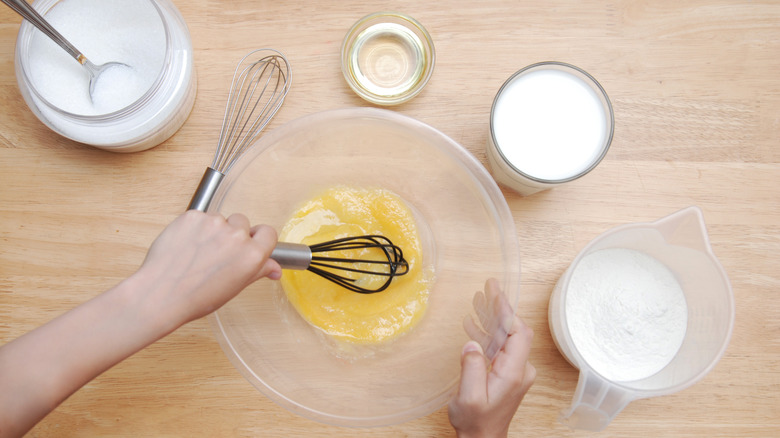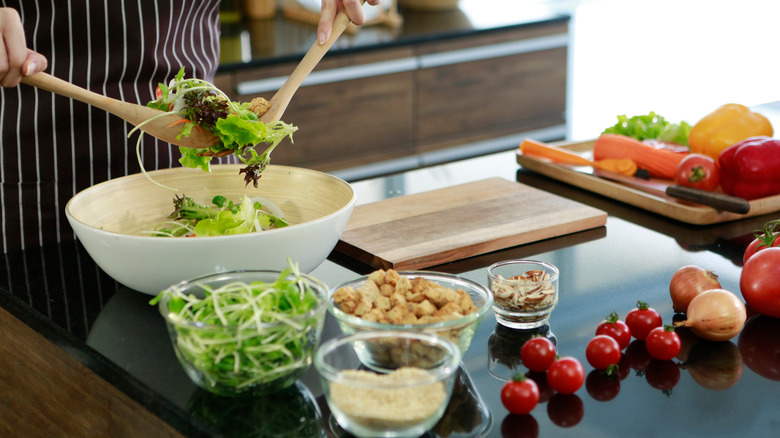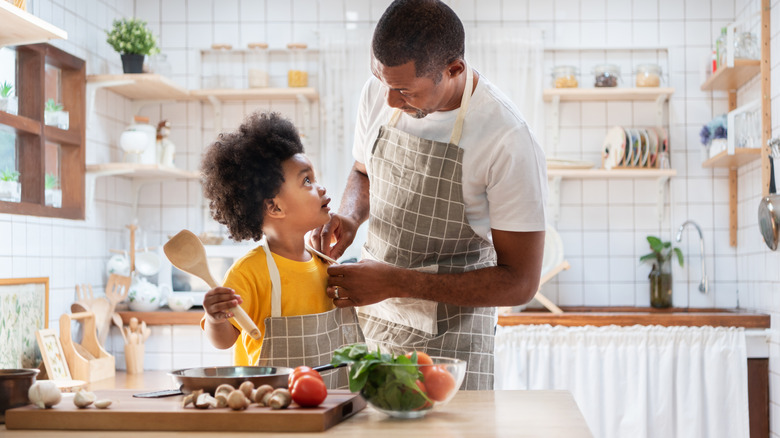The Unexpected Way To Give Yourself A Mental Boost Before Cooking
We may receive a commission on purchases made from links.
Watch any morning show cooking demonstration, and you'll see it. The practice of "mise en place," where the chef divvies up all ingredients into right-sized little bowls, ready to be pinched, sprinkled, or poured with an efficient flick of the wrist.
Mise en place is French for "put in place" or "everything in its place." It got its start by way of Georges-Auguste Escoffier, a famous French chef who brought his military discipline to the kitchen, rigid as that was, as an effort to be fast, efficient, forthright, and correct. He became Europe's first celebrity chef thanks to his ability to suss out ostentatious dishes while maintaining a charm with the upper crust by listening and pivoting according to their individual tastes. His legacy of ditching unnecessary garnishes and doubling down on seasonal flavors made him a powerhouse throughout the culinary universe then and now.
So, it worked. The mise en place regimen that was initially spurned is now beloved, a practical religion to some chefs. Chef icon Anthony Bourdain, in his book Kitchen Confidential, called mise en place a state of readiness that sets our universe in order.
That is just the kind of order that we, the post-pandemic, pre-economic recession, walking wounded, are looking for. Let's dig into how mise en place is good for a mental boost since these days we'll pretty much take any of that we can get.
How setting up our cooking station gives a mental boost
While mise en place is the simple practice of reading your recipe thoroughly, laying out ingredients, and planning the series of events to making your food, you might think of it more as front-loading the hard stuff, so you're free to create in the moment (via Wise Mind Nutrition). The practice has been hijacked from being exclusively culinary and is now applied to work, relationships, and more. Hospitals use it in some teaching environments; yoga health coaches use it in some cases as well.
The phrase gets recalibrated according to whatever environment is coining the term that day, but at its core, it is grounded in shifting the yeoman's portion of labor to upfront tidiness, which creates calm and orderliness, and with that, magic can happen.
Chefs call it the power of "slow down to speed up" (via NPR), but even if your life is not measured in every-single-minute intensity like a line cook, the practice still refreshingly clears the mind. Psychology Today says the spin-off of mise en place for nonchefs is beginning your day by asking yourself if at the end of your day you feel it was successful, what will that mean you've accomplished? Be specific, be tactical, break it down, and be present. It takes practice, but just buying off on the general mise en place philosophy is the first big step.
How attention to one becomes attentiveness to all
What mise en place gave Chef Escoffier was more than an innovative backbone to a new system that managed to crank out hundreds of plates at the London Savoy Hotel (though this was an astronomical feat of the day). It furthermore gave him the space to execute a life hack that most of us try to master with all our might and that is to pay attention and pivot accordingly.
Escoffier's notes on individual preferences spurred his inventiveness. He's credited for more than 5,000 recipes, many named after the person he was accommodating (e.g., Peach Melba for opera singer Nellie Melba). By attending to the personal tastes of his clientele, he elevated even classic recipes, thereby elevating the then low view of kitchen staff into what is now our modern take — that chefs bring talent and creativity to the table and to our personal experiences (via Escoffier School of Culinary Arts).
Today, mise en place is as much a backbone to culinary tradition as Escoffier is to culinary lore. Case in point, the Evening Standard reported earlier this year that Gordon Ramsay's new restaurant, 1890, is named for the year Escoffier started his career at The Savoy. He's a legend with a philosophy that was meant to save time, which is precious, but finding the space to express innovation, productivity — and, dare we say, joy — is a wildly precious mise en place byproduct too.


